An LTM Specialist connects to an LTM device via the serial console cable and receives unreadable output. The LTM Specialist is using the appropriate cable and connecting it to the correct serial port.
Which command should the LTM Specialist run through ssh to verify that the baud rate settings for the serial port are correct on the LTM device?
-- Exhibit –
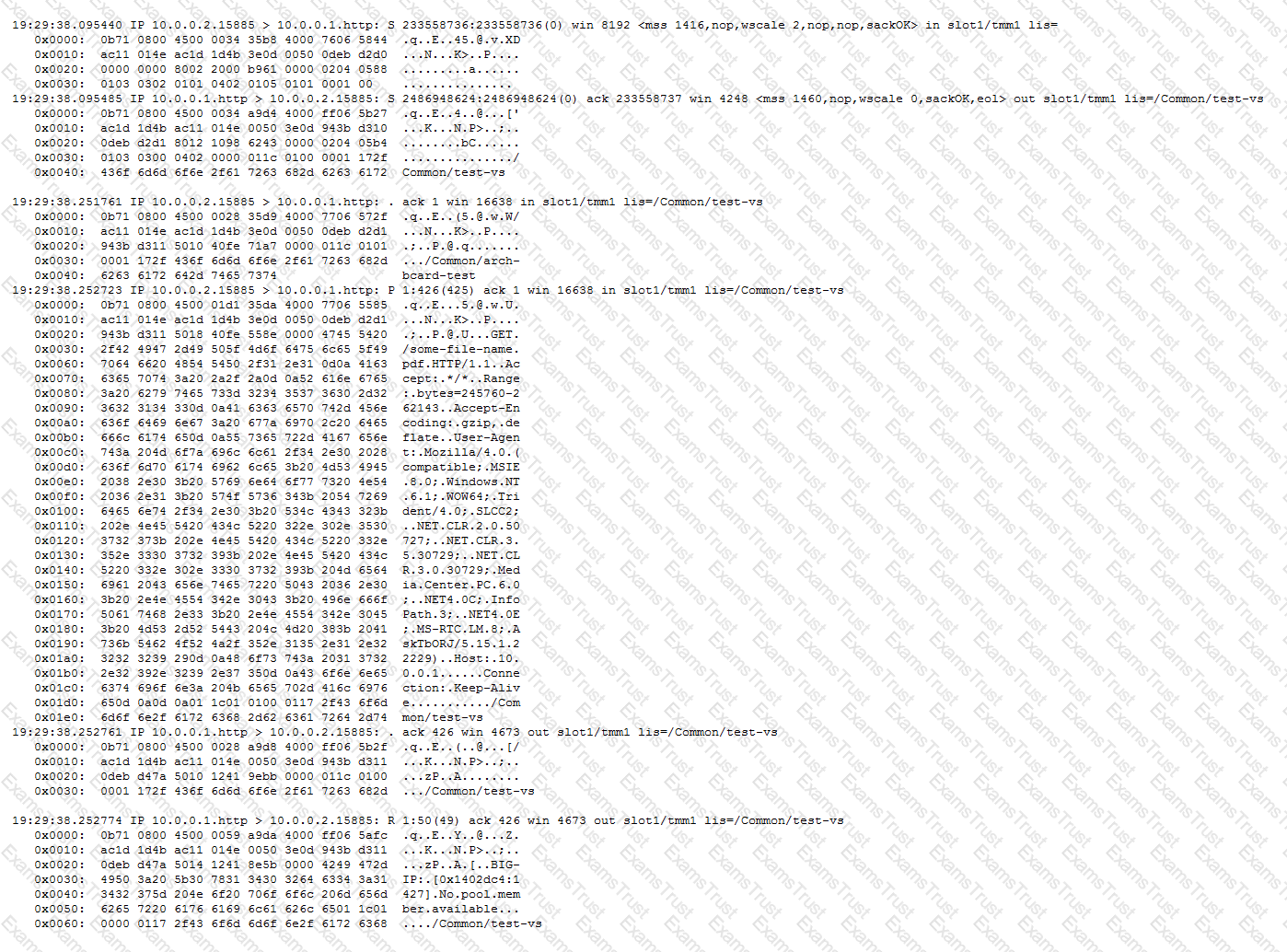
-- Exhibit --
Refer to the exhibit.
A user is unable to access an HTTP application via a virtual server.
What is the cause of the failure?
An LTM device has been configured to log the reasons for generating TCP RST packets.
The following log entry occurs:
"01230140:3: RST sent from 192.168.1.100:80 to 192.168.1.124:39272, [0x112d82a:1721] {peer} TCP RST from remote system."
Which condition will trigger this log entry?
Which two items can be logged by the Application Visibility Reporting analytics profile? (Choose two.)
-- Exhibit –
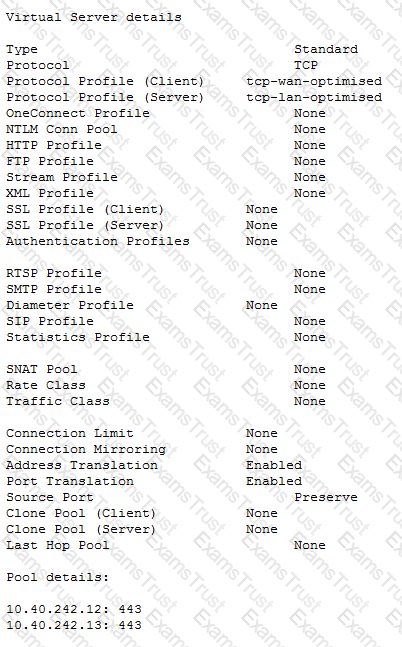
-- Exhibit --
Refer to the exhibit.
An LTM device is used to load balance web content over a secure channel.
The developers of the web content have done a trace using an HTTP profiler application. They believe that allowing the LTM device to compress traffic to the client will improve performance. The client can utilize GZIP or deflate compression algorithms.
An LTM Specialist must implement the compression.
The LTM Specialist has completed the following actions:
1. Create the relevant profile.
2. Apply the relevant profile to the virtual server (VS).
After applying the relevant profile, the LTM device is failing to compress the traffic. Instead, the traffic is being served with an error.
What is the problem?
-- Exhibit –
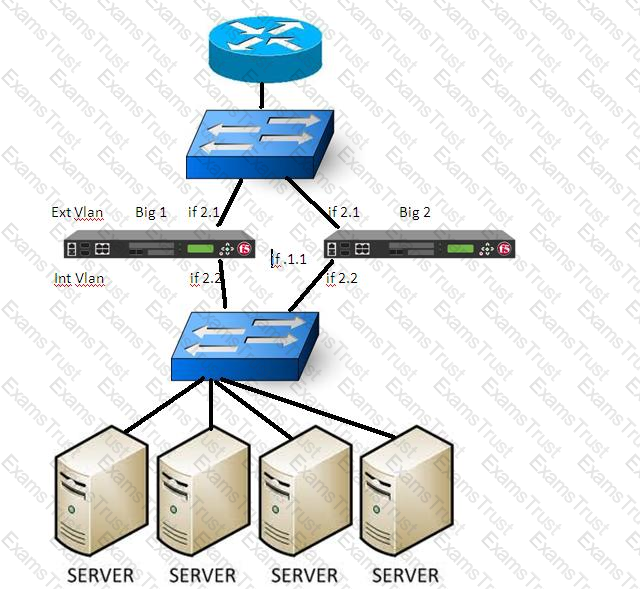
-- Exhibit --
Refer to the exhibit.
A failover has just occured on BIG-IP1. BIG-IP2 is now active and manages traffic as expected. Both Bigip's are set with a gateway failsafe to check the reachability of the main border router. Switches have performed as expected.
Where should the LTM Specialist check for potential issues?
-- Exhibit –
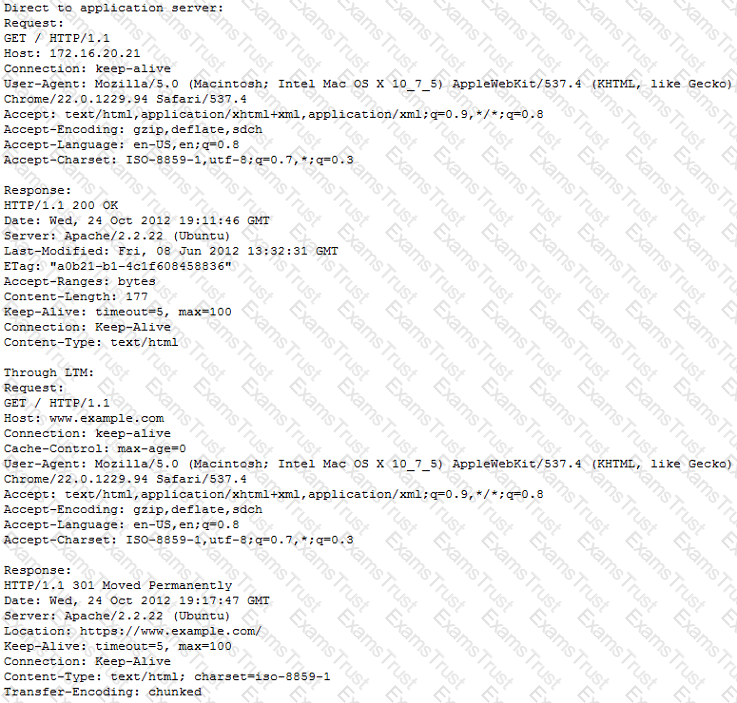
-- Exhibit --
Refer to the exhibit.
An LTM Specialist has created a virtual server to balance connections to a pool of application servers and offload SSL decryption. Clients connect to the application at The virtual server is configured with a clientssl profile but no serverssl profile. The application servers are listening on ports 80 and 443. Users are unable to connect to the application through the virtual server but are able to connect directly to the application server.
What is the root cause of the error?
Given a tcpdump on an LTM device from both sides of a connection on the External and Internal VLANs, how should an LTM Specialist determine if SNAT is enabled for a particular pool?
A client (10.10.1.30) connecting to an HTTPS virtual server (10.10.1.100) with a clientssl profile is getting an SSL error.
Which options will trace this issue?
An application is configured on an LTM device:
Virtual server: 10.0.0.1:80 (VLAN vlan301)
SNAT IP: 10.0.0.1
Pool members: 10.0.1.1:8080, 10.0.1.2:8080, 10.0.1.3:8080 (VLAN vlan302)
Which packet capture should the LTM Specialist perform on the LTM device command line interface to capture only server traffic specifically for this application?
Which two alerting capabilities can be enabled from within an application visibility reporting (AVR) analytics profile? (Choose two.)
-- Exhibit –
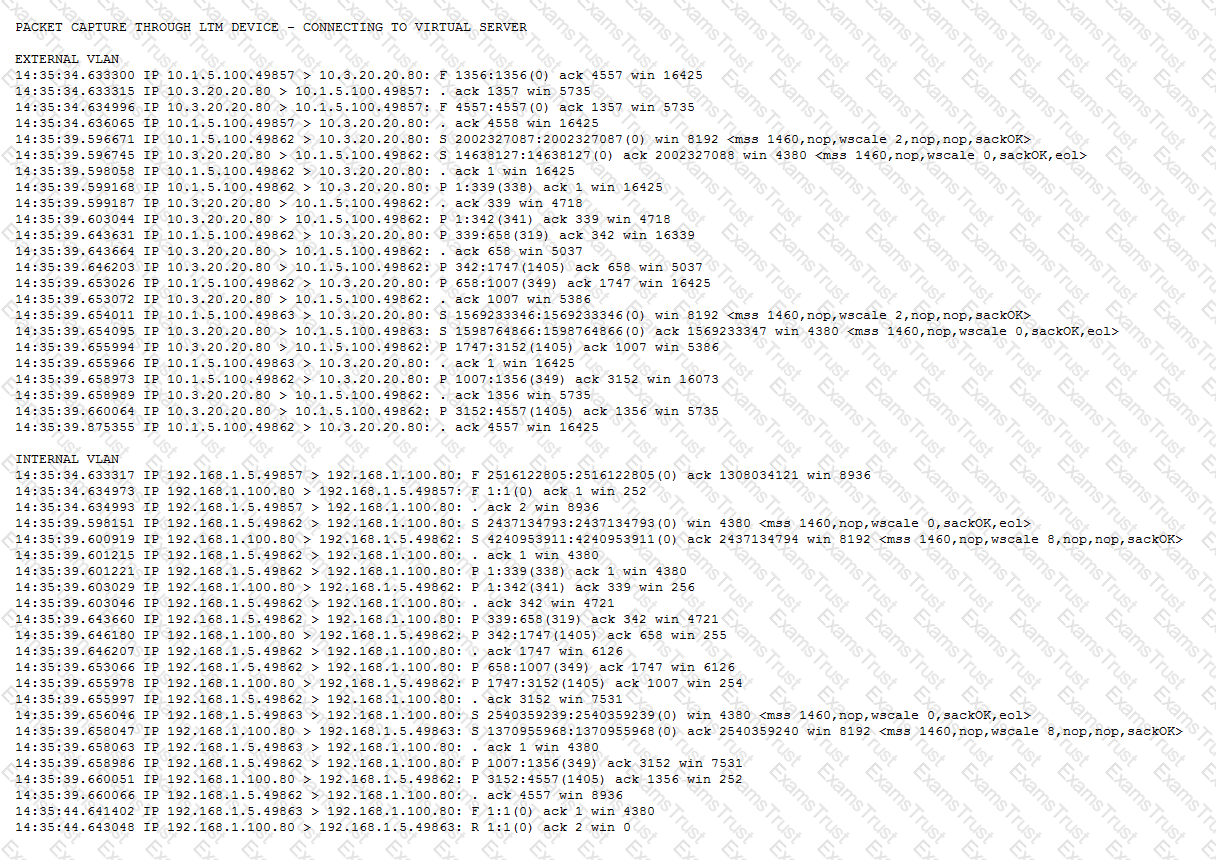

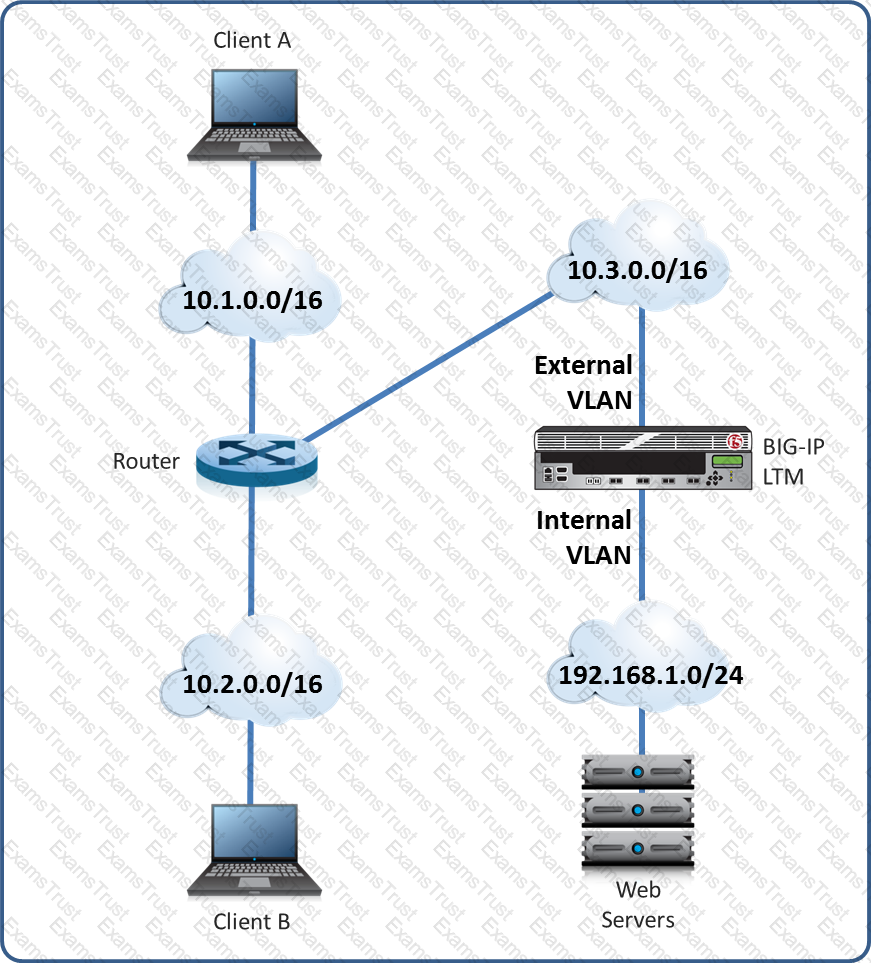
-- Exhibit --
Refer to the exhibits.
Users are able to access the application when connecting to the virtual server but are unsuccessful when connecting directly to the application servers. The LTM Specialist wants to allow direct access to the application servers.
Why are users unable to connect directly to the application servers?
While investigating the cause of a device failover, an LTM Specialist discovers the following events in /var/log/ltm:
01010029:5: Clock advanced by 518 ticks
01010029:5: Clock advanced by 505 ticks
01010029:5: Clock advanced by 590 ticks
01010029:5: Clock advanced by 568 ticks
01010029:5: Clock advanced by 1681 ticks
01010029:5: Clock advanced by 6584 ticks
01140029:5: HA daemon_heartbeat tmm fails action is failover and restart.
010c0026:5: Failover condition, active attempting to go standby.
Which issue caused the failover?
An HTTP 1.1 application utilizes chunking.
Which header should be used to notify the client's browser that there are additional HTTP headers at the end of the message?
An LTM Specialist is receiving reports from customers about multiple applications failing to work properly. The LTM Specialist looks at the services running and notices that the bigd process has NOT started.
How are monitored LTM device objects marked when the bigd process is stopped?
An LTM Specialist is customizing local traffic logging.
Which traffic management OS alert level provides the most detail?
An LTM device pair is configured for failover and connection mirroring. The LTM devices are configured with virtual servers for HTTP, HTTPS with SSL offload, and SSH. An event occurs that causes a failover. HTTP and SSH sessions active at the time of failover remain active, but HTTPS sessions are dropped.
What is the root cause of this problem?
-- Exhibit –

-- Exhibit --
Refer to the exhibit.
An LTM Specialist creates a virtual server to load balance traffic to a pool of HTTPS servers. The servers use client certificates for user authentication. The virtual server has clientssl, serverssl, and http profiles enabled. Clients are unable to connect to the application through the virtual server, but they are able to connect to the application servers directly.
Which change to the LTM device configuration will resolve the problem?
An LTM Specialist needs to modify the logging level for tcpdump execution events. Checking the BigDB Key, the following is currently configured:
sys db log.tcpdump.level {
value "Notice"
}
Which command should the LTM Specialist execute on the LTM device to change the logging level to informational?
An LTM Specialist sees these entries in /var/log/ltm:
Oct 25 03:34:31 tmm warning tmm[7150]: 01260017:4: Connection attempt to insecure SSL server (see RFC5746) aborteD. 172.16.20.1:443
Oct 25 03:34:32 tmm warning tmm[7150]: 01260017:4: Connection attempt to insecure SSL server (see RFC5746) aborteD. 172.16.20.1:443
Oct 25 03:34:32 tmm warning tmm[7150]: 01260017:4: Connection attempt to insecure SSL server (see RFC5746) aborteD. 172.16.20.1:443
Oct 25 03:34:32 tmm warning tmm[7150]: 01260017:4: Connection attempt to insecure SSL server (see RFC5746) aborteD. 172.16.20.1:443
Oct 25 03:34:32 tmm warning tmm[7150]: 01260017:4: Connection attempt to insecure SSL server (see RFC5746) aborteD. 172.16.20.1:443
Oct 25 03:34:33 tmm warning tmm[7150]: 01260017:4: Connection attempt to insecure SSL server (see RFC5746) aborteD. 172.16.20.1:443
Assume 172.16.20.0/24 is attached to the VLAN "internal."
What should the LTM Specialist use to troubleshoot this issue?
-- Exhibit –
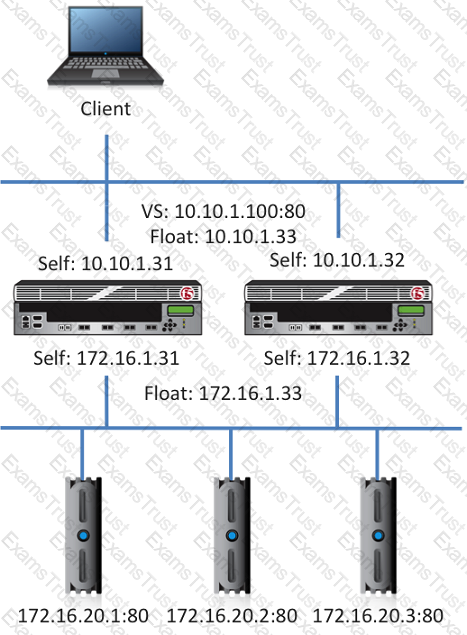
-- Exhibit --
Refer to the exhibit.
A server administrator notices that one server is intermittently NOT being sent any HTTP requests. The server logs display no issues. The LTM Specialist notices log entries stating the node (172.16.20.1) status cycling between down and up. The pool associated with the virtual server (10.10.1.100) has a custom HTTP monitor applied.
Which tcpdump filter will help trace the monitor?
An LTM Specialist has been asked to configure a virtual server to distribute connections between a pool of two application servers with addresses 172.16.20.1 and 172.16.20.2. The application servers are listening on TCP ports 80 and 443. The application administrators have asked that clients be directed to the same node for both HTTP and HTTPS requests within the same session.
Virtual servers vs_http and vs_https have been created, listening on 1.2.3.100:80 and 1.2.3.100:443, respectively.
Which configuration option will result in the desired behavior?
When re-licensing an LTM device from the command line interface, which tmsh command should the LTM Specialist use to generate the required information to provide on the F5 licensing portal?
An LTM Specialist has just manually failed the active LTM device over to the standby LTM device. The LTM Specialist notices the newly active LTM device is NOT currently receiving traffic. The LTM Specialist verifies the newly active device is responding to ARP but still no traffic is hitting the virtual servers. The LTM Specialist also notices that the virtual servers eventually start responding.
What should be added to the configuration to resolve the problem?
-- Exhibit –
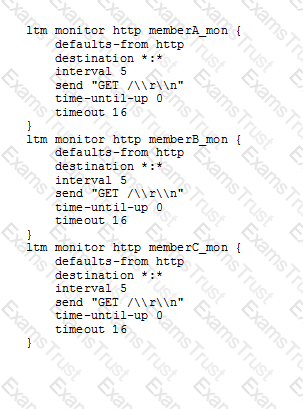
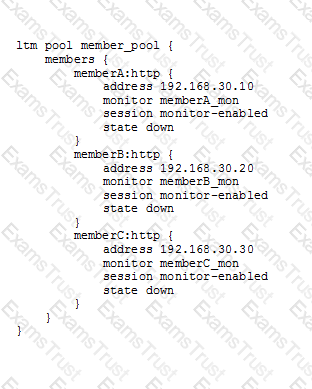
-- Exhibit --
Refer to the exhibits.
How should the LTM Specialist minimize the configuration?
An LTM device is load balancing telnet and ssh applications in a client/server environment experiencing significant packet delay.
Which setting in the TCP profile should reduce the amount of packet delay?
-- Exhibit –
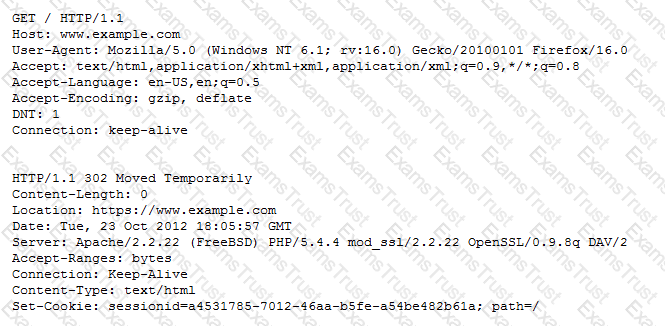
-- Exhibit --
Refer to the exhibit.
An LTM Specialist is performing an HTTP trace on the client side of the LTM device and notices there are many undesired headers being sent by the server in the response. The LTM Specialist wants to remove all response headers except "Set-Cookie" and "Location."
How should the LTM Specialist modify the HTTP profile to remove undesired headers from the HTTP response?
-- Exhibit –

-- Exhibit --
Refer to the exhibit.
The virtual server is listening on port 443.
What is the solution to the problem?
An LTM HTTP pool has an associated monitor that sends a string equal to 'GET /test.html'.
Which two configurations could an LTM Specialist implement to allow server administrators to disable their pool member servers without logging into the LTM device? (Choose two.)
An LTM Specialist with the Administrator role and terminal access of "tmsh" logs in via ssh and is in the Traffic Manager Shell. The LTM Specialist wants to enter the bash shell to review log files.
Which command does the LTM Specialist need to run to access the bash shell?
An LTM Specialist has a OneConnect profile and HTTP profile configured on a virtual server to load balance an HTTP application.
The following HTTP headers are seen in a network trace when a client connects to the virtual server:
Clientside:
GET / HTTP/1.1
Host: 192.168.136.100
User-Agent: Mozilla/5.0
Accept: text/html,application/xhtml+xml,application/xml;q=0.9,*/*;q=0.8
Accept-EncodinG. gzip, deflate
Connection: keep-alive
Serverside:
HTTP/1.1 200 OK
DatE. 5 Jun 1989 17:06:55 GMT
Server: Apache/2.2.14 (Ubuntu)
Vary: Accept-Encoding
Content-EncodinG. gzip
Content-LengtH. 3729
X-Cnection: close
Content-TypE. text/html
The LTM Specialist notices the OneConnect feature is working incorrectly.
Why is OneConnect functioning incorrectly?